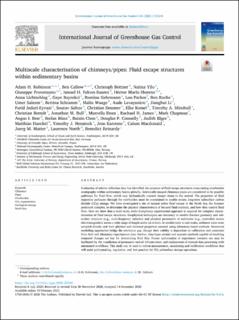Multiscale characterisation of chimneys/pipes: Fluid escape structures within sedimentary basins
Robinson, Adam H.; Callow, Ben; Böttner, Christoph; Yilo, Naima; Provenzano, Giuseppe; Falcon-Suarez, Ismael H; Marin-Moreno, Héctor; Lichtschlag, Anna; Bayrakci, Gaye; Gehrmann, Romina; Parkes, Lou; Roche, Ben; Saleem, Umer; Schramm, Bettina; Waage, Malin; Lavayssière, Aude; Li, Jianghui; Jedari-Eyvazi, Farid; Sahoo, Sourav; Deusner, Christian; Kossel, Elke; Minshull, Timothy A.; Berndt, Christian; Bull, Jonathan M.; Dean, Marcella; James, Rachael H.; Chapman, Mark; Best, Angus I.; Bünz, Stefan; Chen, Baixin; Connelly, Douglas P.; Elger, Judith; Haeckel, Matthias; Henstock, Timothy J.; Karstens, Jens; Macdonald, Calum; Matter, Juerg M.; North, Laurence; Reinardy, Benedict
Peer reviewed, Journal article
Published version
Permanent lenke
https://hdl.handle.net/11250/2756125Utgivelsesdato
2021Metadata
Vis full innførselSamlinger
- NGI articles [1037]
Originalversjon
International Journal of Greenhouse Gas Control. 2021, 106 1-26. 10.1016/j.ijggc.2020.103245Sammendrag
Evaluation of seismic reflection data has identified the presence of fluid escape structures cross-cutting overburden stratigraphy within sedimentary basins globally. Seismically-imaged chimneys/pipes are considered to be possible pathways for fluid flow, which may hydraulically connect deeper strata to the seabed. The properties of fluid migration pathways through the overburden must be constrained to enable secure, long-term subsurface carbon dioxide (CO2) storage. We have investigated a site of natural active fluid escape in the North Sea, the Scanner pockmark complex, to determine the physical characteristics of focused fluid conduits, and how they control fluid flow. Here we show that a multi-scale, multi-disciplinary experimental approach is required for complete characterisation of fluid escape structures. Geophysical techniques are necessary to resolve fracture geometry and subsurface structure (e.g., multi-frequency seismics) and physical parameters of sediments (e.g., controlled source electromagnetics) across a wide range of length scales (m to km). At smaller (mm to cm) scales, sediment cores were sampled directly and their physical and chemical properties assessed using laboratory-based methods. Numerical modelling approaches bridge the resolution gap, though their validity is dependent on calibration and constraint from field and laboratory experimental data. Further, time-lapse seismic and acoustic methods capable of resolving temporal changes are key for determining fluid flux. Future optimisation of experiment resource use may be facilitated by the installation of permanent seabed infrastructure, and replacement of manual data processing with automated workflows. This study can be used to inform measurement, monitoring and verification workflows that will assist policymaking, regulation, and best practice for CO2 subsurface storage operations.
